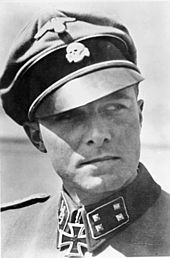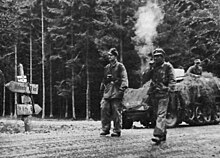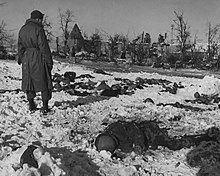1st SS Panzer Division Leibstandarte SS Adolf Hitler
Schreck resurrected the use of the Totenkopf ("death's head") as the unit's insignia, a symbol various elite forces had used in the past, including specialized assault troops of Imperial Germany in World War I who used Hutier infiltration tactics.[17] The term Leibstandarte was derived partly from Leibgarde – a somewhat archaic German translation of "Guard of Corps" or personal bodyguard of a military leader ("Leib" = lit."body, torso") – and Standarte: the Schutzstaffel (SS) or Sturmabteilung (SA) term for a regiment-sized unit, also the German word for a specific type of heraldic flag (Standard).[23] In what the Nazis called the Röhm Putsch, but otherwise came to be known as the Night of the Long Knives, companies of the LSSAH, together with the Gestapo and Göring's Landespolizeigruppe, performed Death Squad actions.At Pabianice, a town near Łódź, the LSSAH fought elements of the Polish 28th Infantry Division and the Wołyńska Cavalry Brigade in close combat.It was to form the vanguard of the ground advance into the Netherlands, tasked with capturing a vital bridge over the IJssel, attacking the main line of defense at the Grebbeberg (the Grebbeline), and linking up with the Fallschirmjäger of Generaloberst Kurt Student's airborne forces, the 7.It was there that troops of the LSSAH 2nd battalion, under the command of SS-Hauptsturmführer Wilhelm Mohnke committed the Wormhoudt massacre, where 80 British and French prisoners of war were killed.SS-Sturmbannführer Kurt Meyer's reinforced Aufklärungs-Abteilung (reconnaissance battalion), LSSAH was tasked with clearing resistance from the Kleisoura Pass south-west of Vevi and driving through to the Kastoria area to cut off retreating Greek and British Commonwealth forces.On 20 April, following a pitched battle in the 5,000-foot-high (1,500 m) Metsovon Pass in the Pindus Mountains, the commander of the Greek Epirus army surrendered the entire force to Dietrich.It was moved to Czechoslovakia in mid May for reorganization until being ordered to assemble in Poland[49] for Operation Barbarossa, as part of Gerd von Rundstedt's Army Group South.There was not enough time to deliver all its equipment and refit it to full divisional status before the launch of the invasion of the Soviet Union, so the new "division" remained the size of a reinforced brigade, even though its expansion and development was of concern at the very highest ranks of command.According to a postwar report by Waffen-SS journalist Erich Kern, the division murdered 4,000 Soviet prisoners in reprisal on 18 August, after finding the mutilated bodies of six dead divisional members who had been executed at Nowo Danzig, north of Kherson.Manstein deployed LSSAH to create diversions while preparing for the main assault, intending to employ it to exploit an eventual breakthrough, but was forced to throw pioneers into the attack on the "Tatar Ditch" in the face of a furious counterattacks and did not break the Soviet defense for ten days.[46] Under pressure from heavy Soviet counterattacks during the winter, the LSSAH and Army Group South retreated from Rostov to defensive lines on the river Mius.[46] After the spring rasputitsa (seasonal mud) had cleared, the division joined in Fall Blau, participating in the fighting to retake Rostov-on-Don, which fell in late July 1942.Severely understrength, the LSSAH was transferred to the Normandy region of occupied France to join the newly formed SS Panzer Corps and to be reformed as a Panzergrenadier division.[61] During the fighting around Kharkov, a unit under the command of Joachim Peiper gained a nickname "Blowtorch Battalion", after the inhabitants of two Soviet villages were shot or burned.SS-Untersturmführer Krämer (captured on the Western Front during his service with the SS Division Hitlerjugend) recounted the following from his time with the LSSAH:[67] I have experienced it in Russia at Orel.The LSSAH, along with the SS Divisions Totenkopf and Das Reich, was to form the spearhead of General Hermann Hoth's 4th Panzer Army, tasked with breaching the southern flank of the Kursk salient.Untersturmführer Michael Wittman, a Tiger commander in Leibstandarte's heavy company, destroyed eight enemy tanks and seven anti-tank guns on the first day of battle.[74] The Russian attack was now faltering, so Staudegger pressed his Tiger forward into the retreating enemy flanks, switching to high-explosive shells after exhausting his armor-piercing ammmunition.With the battle at Prokhorovka still in the balance, Soviet High Command launched an offensive of their own, Operation Kutuzov, near Orel causing Hitler to order the cessation of Citadel.The division was sent to Italy to help stabilize the situation there caused by the deposal of Benito Mussolini by the Badoglio government and the Allied invasion of Sicily which began on the night of 9–10 July 1943.[83] During the night of 14–15 July, LSSAH was relieved by the 272nd Infantry Division and pulled back to an assembly area astride the Caen – Falaise road between Ifs and Cintheaux.British VIII Corps, with three armored divisions, launched the attack aiming to seize the German-held Bourguébus Ridge, along with the area between Bretteville-sur-Laize and Vimont.The SS Division Das Reich recaptured Mortain, and an armored battle group under Joachim Peiper reached Bourlopin, but had to halt due to US counterattacks and air strikes.At 12:30, near the hamlet of Baugnez, on the height halfway between the town of Malmedy and Ligneuville, Peiper's Kampfgruppe encountered a convoy of the 285th Field Artillery Observation Battalion, US 7th Armored Division.Along with other Americans captured earlier (127 men total), they were disarmed and sent to stand in a field near the crossroads, where the Germans shot them en masse with machine guns and pistols.Unable to defeat them, he left a smaller support force in town and headed for the bridge at Trois-Ponts with the bulk of his strength, but by the time he reached it, retreating US engineers had already destroyed it.As their situation in Stoumont was becoming hopeless, Peiper decided to pull back to La Gleize where he set up his defenses, waiting for the German relief force.















skeleton keyNazi GermanyWaffen-SSPanzerArmoured warfareDivisionAdolf HitlerAnschlussGerman occupation of CzechoslovakiaWorld War IIInvasion of PolandBattle of the NetherlandsBattle of FranceBattle of GreeceOperation BarbarossaThird Battle of KharkovWestern Front 1943Battle of KurskKamenets–Podolsky pocketWestern Front 1944Operation LüttichFalaise pocketArdennes OffensiveOperation SouthwindOperation Spring AwakeningBattle of BerlinJulius SchreckSepp DietrichPaul HausserGermanbodyguardregimentdivision-sizedSS-VerfügungstruppeSS-TotenkopfverbändePanzergrenadierPanzer divisionMalmedy massacreprisoners of warNazi PartyErnst RöhmSturmabteilungJoseph BerchtoldTotenkopfImperial GermanyWorld War IHutierinfiltration tacticsBeer Hall PutschMunichVexillumSchutzstaffel1st SS-StandarteReich ChancelleryLeibgardeBerlin-LichterfeldeHeinrich HimmlerStabschef-SAJürgen WagnerBad WiesseeNight of the Long KnivesGestapoDeath SquadNuremberg RalliesSaarlandBohemiaMoraviaStandartenXIII. ArmeekorpsArmy Group Southlock pickI SS Panzer Corps17. Infanterie-DivisionPolish cavalryPabianiceŁódźPolish 28th Infantry DivisionWołyńska Cavalry BrigadeBłonieZłoczewTorzeniecGoworowoMławaWłocławekWarsaw4. Panzer-DivisionGeorg-Hans ReinhardtSturmgeschützFall GelbIJsselFallschirmjägerKurt Student7. Flieger-Division22. Luftlande-Infanterie-DivisionSturmgeschütz IIIZutphenRotterdamThe Haguecounterattack at ArrasSS-Verfügungs-DivisionDunkirkBritish Expeditionary ForceWattenbergBritishKnight's Cross of the Iron CrossWormhoutRoyal Warwickshire RegimentFrench soldiersEsquelbecqWilhelm MohnkeWormhoudt massacreMoselleBatterieMoselle RiverOperation SeelöweBattle of BritainBulgariaOperation MaritaGreeceYugoslavia9. Panzer-DivisionGeorg StummeXL Panzer CorpsBitolaSd.Kfz. 231 armored carsBalkans
